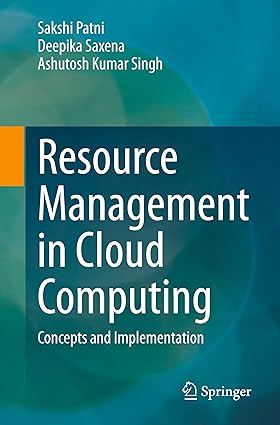
Resource Management in Cloud Computing:Concepts and Implementation
by: Sakshi Patni (Author), Deepika Saxena (Author),Ashutosh Kumar Singh (Author)
Publisher: Springer
Publication Date: 2025-02-11
Language: English
Print Length: 240 pages
ISBN-10: 3031830520
ISBN-13: 9783031830525
Book Description
This book addresses fundamental concepts and practical implementations in cloud computing environments, focusing on load balancing and resource management. As cloud computing's popularity grows, expertise in infrastructure management is crucial for delivering flawless subscription-based services and hosted data solutions. The book presents novel models for cloud resource management to improve operational efficiency through better virtual machine (VM) placements. Beginning with task scheduling and resource allocation basics, the book progresses to resource management concepts. It introduces innovative models for dynamic resource allocation, heuristic approaches for optimal host selection, secure resource management frameworks, multi-objective VM allocation schemes, and data security models. A significant contribution is an effective model integrating load balancing, resource management, Quality of Service (QoS), security, and cloud performance for Infrastructure as a Service (IaaS). The book offers innovative methodologies for dynamic resource allocation and service administration in cloud datacenters. It presents traffic management techniques to reduce energy consumption, improve resource utilization, and enhance security through optimized VM placement, with experimental validation. These models improve response time, throughput, resource utilization, energy consumption, and failure node management. Security is addressed through secure VM placement strategies, making it harder for attackers to achieve co-tenancy. A multi-objective approach for secure load balancing optimizes multiple conflicting objectives simultaneously. The book includes cyber-threat countermeasures and provides recommendations for organizations and users. Suitable for senior undergraduate and graduate courses in cloud computing, resource allocation, security, and energy consumption methods, the book includes examples and tutorials using Cloudsim tools for beginners. This helps them understand virtual infrastructure and service design. The methodologies benefit both cloud service providers and customers, offering cost-effective solutions for revenue maximization. The comprehensive approach makes the book valuable for academic study and practical application in cloud computing environments.
Editorial Reviews
This book addresses fundamental concepts and practical implementations in cloud computing environments, focusing on load balancing and resource management. As cloud computing's popularity grows, expertise in infrastructure management is crucial for delivering flawless subscription-based services and hosted data solutions. The book presents novel models for cloud resource management to improve operational efficiency through better virtual machine (VM) placements. Beginning with task scheduling and resource allocation basics, the book progresses to resource management concepts. It introduces innovative models for dynamic resource allocation, heuristic approaches for optimal host selection, secure resource management frameworks, multi-objective VM allocation schemes, and data security models. A significant contribution is an effective model integrating load balancing, resource management, Quality of Service (QoS), security, and cloud performance for Infrastructure as a Service (IaaS). The book offers innovative methodologies for dynamic resource allocation and service administration in cloud datacenters. It presents traffic management techniques to reduce energy consumption, improve resource utilization, and enhance security through optimized VM placement, with experimental validation. These models improve response time, throughput, resource utilization, energy consumption, and failure node management. Security is addressed through secure VM placement strategies, making it harder for attackers to achieve co-tenancy. A multi-objective approach for secure load balancing optimizes multiple conflicting objectives simultaneously. The book includes cyber-threat countermeasures and provides recommendations for organizations and users. Suitable for senior undergraduate and graduate courses in cloud computing, resource allocation, security, and energy consumption methods, the book includes examples and tutorials using Cloudsim tools for beginners. This helps them understand virtual infrastructure and service design. The methodologies benefit both cloud service providers and customers, offering cost-effective solutions for revenue maximization. The comprehensive approach makes the book valuable for academic study and practical application in cloud computing environments.
 Wow! eBook
Wow! eBook

